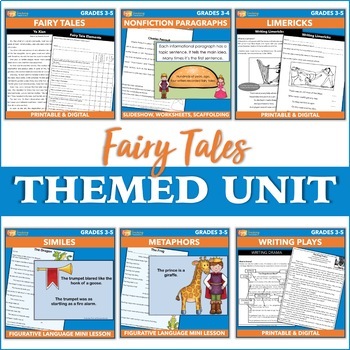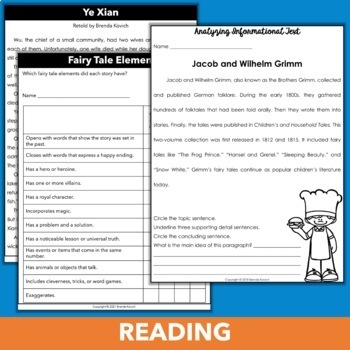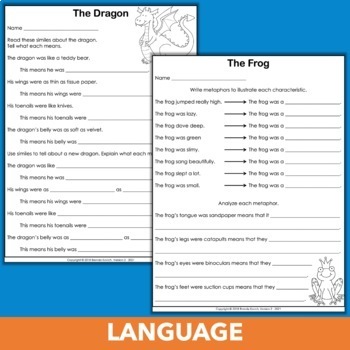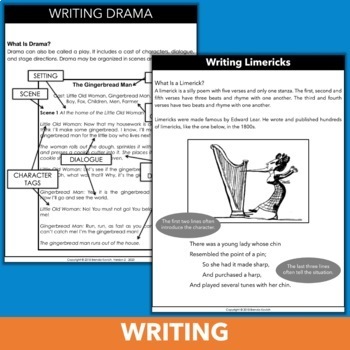Fairy Tales Unit - Themed ELA Activities for Third and Fourth Grade Students
Brenda Kovich
5.8k Followers
Grade Levels
3rd - 4th, Homeschool
Subjects
Resource Type
Standards
CCSSRL.3.5
CCSSRL.4.5
CCSSRL.4.9
CCSSRI.3.2
CCSSRI.3.5
Formats Included
- Zip
- Easel Activity
Pages
165 pages
Brenda Kovich
5.8k Followers
Easel Activities Included
Some resources in this bundle include ready-to-use interactive activities that students can complete on any device. Easel by TPT is free to use! Learn more.
Products in this Bundle (9)
showing 1-5 of 9 products
Bonus
Bonus Files
Description
Themed activities engage third and fourth graders in reading, language, and writing about fairy tales from around the world. They analyze multicultural folktales, learn about nonfiction paragraph structure, identify similes and metaphors, write limericks and plays.
Open the preview to take a closer look at the ELA unit.
- Kids read four stories from different cultures: “Cinderella, or the Glass Slipper” (France), “The Fisherman and the Genie” (Middle East), “Ye Shen” (China), and “The Talking Eggs” (Louisiana).
- They learn about fairy tale elements and locate them in their reading.
- Activities for summarizing, comparing and contrasting are also included.
Analyzing Informational Paragraph Structure
- Students learn the basic structure of an informational paragraph.
- They analyze paragraphs about authors of traditional European fairy tales to find the topic, detail, and concluding sentences.
- Instruction culminates by scaffolding to the structure of a five-paragraph article.
- A slideshow teaches kids about similes and provides fairy tale examples.
- An exit ticket asks them to analyze four dragon-themed sentences with similes and tell what they mean.
- Then students write their own dragon similes.
- A slideshow teaches kids about metaphors and provides fairy tale examples.
- Given eight situations, they generate frog-themed metaphors.
- Then they analyze more frog figurative language and tell what it means.
- Students explore several limericks by Edward Lear.
- Then they learn about the structure of this form of poetry.
- Finally, kids write their own limericks about fairy tale characters. Fifteen themed templates are included: “Beauty and the Beast,” “Cinderella,” “The Emperor’s New Clothes,” “Goldilocks and the Three Bears,” “The Goose Girl,” “Hansel and Gretel,” “Jack and the Beanstalk,” “The Little Mermaid,” “The Princess and the Pea,” “Little Red Riding Hood,” “Puss in Boots,” “Rapunzel,” “Sleeping Beauty,” “Snow White,” and “The Three Little Pigs.”
- Kids learn about structural elements of poetry and practice.
- Then they rewrite age-appropriate fairy tales in dramatic form. Five stories are included: “Jack and the Beanstalk,” “Chicken Little,” “Goldilocks and the Three Bears,” “The Three Little Pigs,” and “The Frog Prince.”
- Fifteen days of fairy tale-themed lesson plans provide a sample schedule.
- You can use them to drive instruction – or pick and choose to create your own unit of study.
Bonus Files
- Kids add similes to a Mad-Libs style “Snow White” twisted tale.
- As they read a special version of “The Frog Prince,” they identify similes and metaphors.
Enjoy teaching!
Brenda Kovich
Total Pages
165 pages
Answer Key
Included
Teaching Duration
2 Weeks
Report this resource to TPT
Reported resources will be reviewed by our team. Report this resource to let us know if this resource violates TPT’s content guidelines.
Standards
to see state-specific standards (only available in the US).
CCSSRL.3.5
Refer to parts of stories, dramas, and poems when writing or speaking about a text, using terms such as chapter, scene, and stanza; describe how each successive part builds on earlier sections.
CCSSRL.4.5
Explain major differences between poems, drama, and prose, and refer to the structural elements of poems (e.g., verse, rhythm, meter) and drama (e.g., casts of characters, settings, descriptions, dialogue, stage directions) when writing or speaking about a text.
CCSSRL.4.9
Compare and contrast the treatment of similar themes and topics (e.g., opposition of good and evil) and patterns of events (e.g., the quest) in stories, myths, and traditional literature from different cultures.
CCSSRI.3.2
Determine the main idea of a text; recount the key details and explain how they support the main idea.
CCSSRI.3.5
Use text features and search tools (e.g., key words, sidebars, hyperlinks) to locate information relevant to a given topic efficiently.





